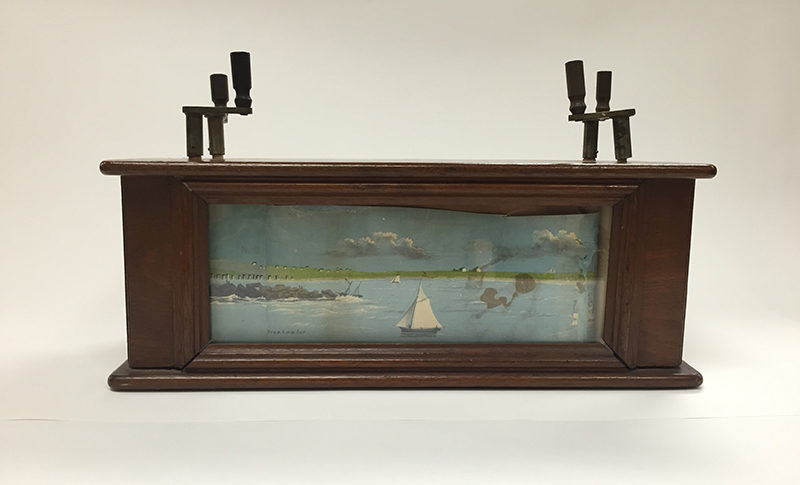The Decorative Arts Collection includes an eclectic mix of donations to the library including works on paper, furniture, ceramics, and curiosities. Materials from these collections can be viewed throughout the library.

Egyptian Elephant Folio Cabinet, 1838–40. John Russell Bartlett (American, 1805–1886) and Frederick Catherwood (English, 1799–1854) / Millard & Lee Cabinetmakers (1838–1851), cabinetry; John Russell Bartlett and Kinsley C. Gladding (American, 1802–1866), painting. Pine and walnut frame with gold-green ground and painted canvas.
Bibliophile John Russell Bartlett was a major figure in the history of the Providence Athenæum. A cofounder of the 1831 Providence Athenæum (one of the progenitors of the current Athenæum as we know it today), he served as its first librarian and cataloger of books, and was a member of the committee that oversaw acquisitions. He especially encouraged the purchase of important elephant and double elephant folios, including the imperial edition of Description de l’Egypte, a richly illustrated, multi-volume series that traced the history of ancient and modern Egypt. Yet such large tomes—between two and three feet long—demanded special accommodations. For the Athenæum’s copy of Description de l’Egypte, acquired in 1838, Bartlett and English architect Frederick Catherwood designed this special cabinet to store it. The cabinet was intended to evoke an Egyptian temple, with exterior decoration specifically drawn from plates in the Description, elegantly fusing the cabinet’s exterior with its contents. Bartlett and Catherwood's grand construction also serves as an analogy for the Athenæum itself, likewise a temple for books and learning.

Edgar Allan Poe, November 13, 1848. William Hartshorn / Masury and Hartshorn Studio, Westminster Street, Providence. Copy of Daguerreotype. Gift of the John Hay Library, Brown University.
Edgar Allan Poe sat for this daguerreotype, known as the Whitman or Hartshorn Daguerreotype, on November 13, 1848 at the Westminster Street studio of Masury and Hartshorn in Providence, Rhode Island, after a tumultuous week which included an overdose of laudanum and a bout of heavy drinking. The daguerreotype was a gift from Poe to Sarah Helen Whitman, given to her after she finally consented to marry him. The engagement did not last long, but Whitman kept the daguerreotype until 1874. In a letter she noted Poe’s “sweet and serene expression” in the image. The daguerreotype was gifted to the Brown University Library in 1905.

Raven Bookplate, ca. 1870s. Edouard Manet (French, 1832–1883). Lithographic Print inscribed with black and brown ink on white tracing paper. Gift of the Chace Family, 1948.
This bookplate, inscribed by French author Stephen Mallarmé to the poet and former fiancée of Edgar Allan Poe, Sarah Helen Whitman, is an emblem of their intellectual accord. Since his youth, Mallarmé had been a tremendous admirer of Poe, and in 1875 he published a French translation of Poe's "The Raven," with evocative black-and-white illustrations by Edouard Manet. By this time, Poe's standing had suffered at the hands of his literary executor, Rufus Wilmot Griswold, who cast him as a dissolute alcoholic. Whitman endeavored to rehabilitate his reputation with her publication of Edgar Poe and his Critics (1860), as did English scholar John Henry Ingram in his four-volume The Works of Edgar Allan Poe (1874–75). Indeed, it was likely Ingram who provided the introduction between Mallarmé and Whitman, and the two began a transatlantic correspondence. Mallarmé is known to have sent at least seven letters to Whitman, as well as copies of his translation of “The Raven.” In a letter from 1876 he clarified why her opinion of his work on Poe was of such importance: "Your name," he explained, "mingles with his."

Coliseum, 1859-60. Attributed to Tomasso Cuchionni (Italian, 1790-1864) [Wet-plate collodion negative printed with silver]. The five-foot photograph is constructed of three prints expertly seamed. Presented by Albert J. Jones, 1860.
A panoramic photograph of the Coliseum was sent to the Athenaeum from Rome by member Albert J. Jones in 1860. The photograph was framed in Providence by the Board of Directors at the Vose Gallery and was displayed in the main hall from the mezzanine for many years.

Excursion Views of Narragansett Bay and Block Island, 1878. Excursion View Company, Providence. Patented in 1878, the color lithographic rolls depicting the landscape were printed by Clay and Company in Buffalo, NY.
One of the more unusual curiosities in the Philbrick Rare Book Room is the hand cranked panorama, or, Excursion Views of Narragansett Bay and Block Island. The panorama is described in a recent book as a “two-sided moving panorama viewer for the desktop, with two picture rolls depicting continuous boat trips along the waterways of Rhode Island and Massachusetts” (Illusions in Motion, MIT, 2013). It is unknown how the Athenæum acquired the panoramic viewer.

Banjo Variant Wall Timepiece c. 1870. George D. Hatch, North Attleboro, MA.
Banjo shaped case with straight throat and round lower door, black, red and gilt glasses, and painted zinc dial. North Attleboro, Massachusetts had a long tradition of metal working trades and was a center of clock manufacturing from about 1840-1880. Banjo timepieces became popular with production manufactures because the plain cases and dials appealed to bank, office, school, and railroad customers in the nineteenth century. It is likely that the clock was purchased by the Athenæum to hang in the library to keep time for staff and patrons.



